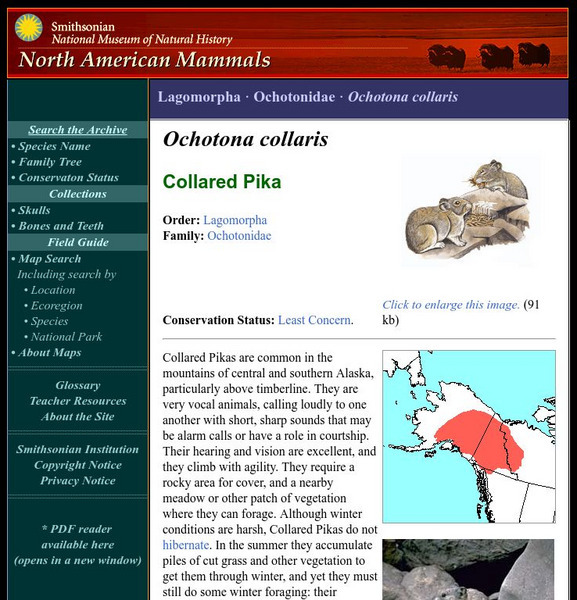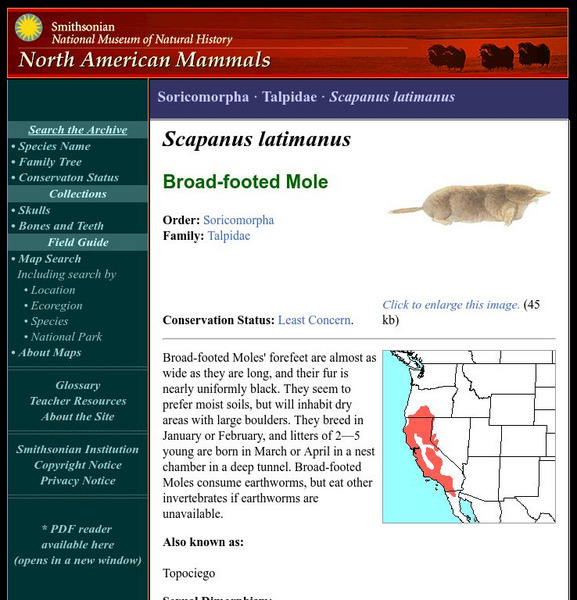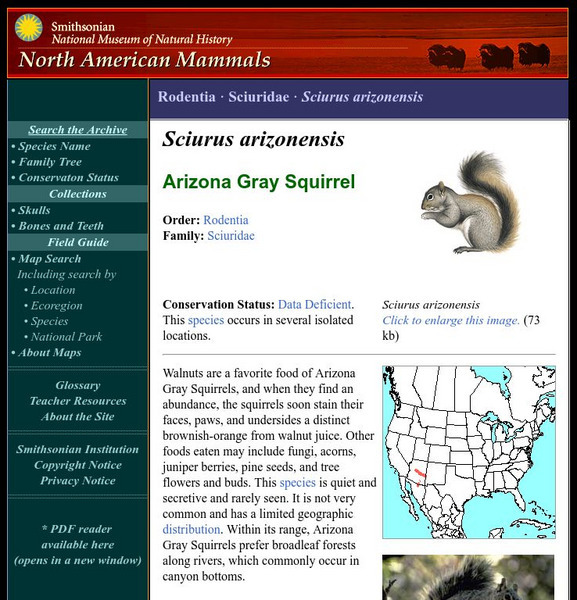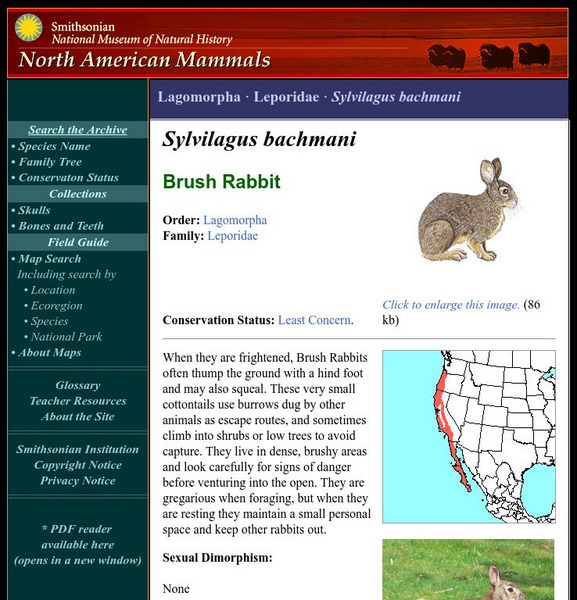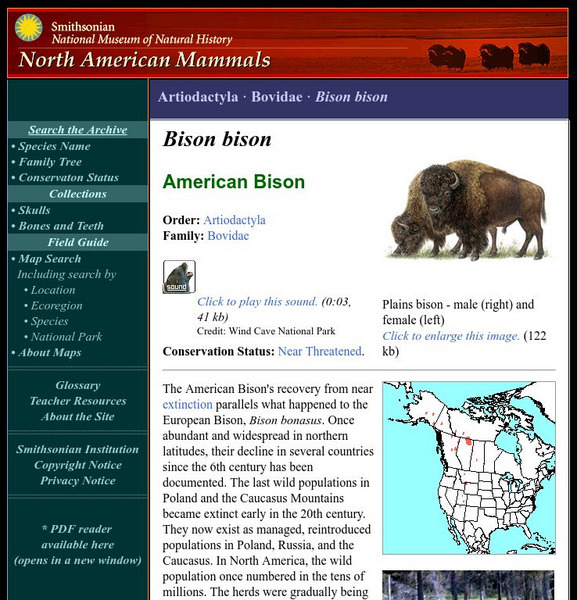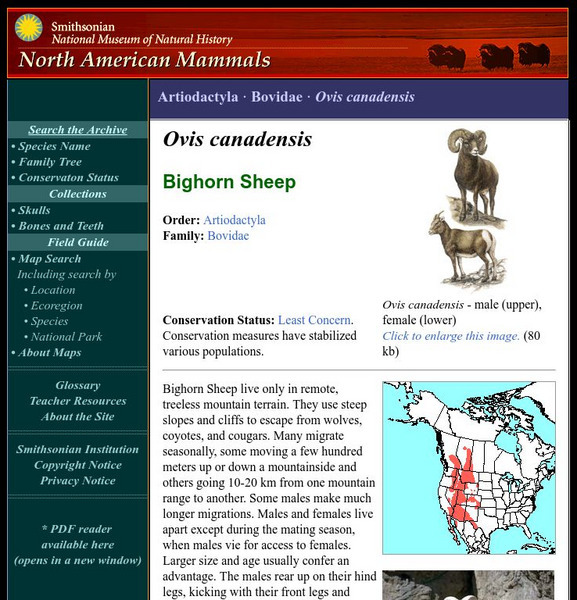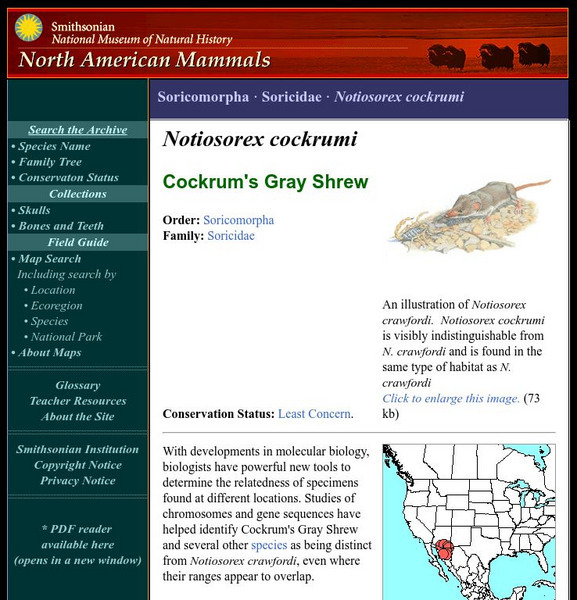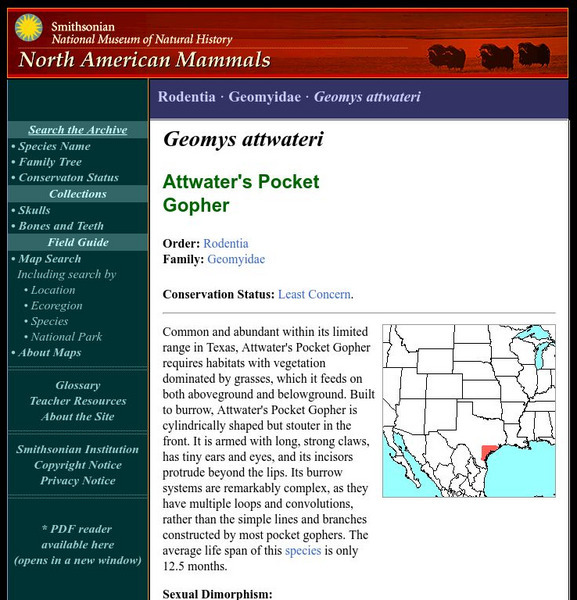Smithsonian Institution
National Museum of Natural History: American Mammals: Collared Pika
Collared Pikas are common in the mountains of central and southern Alaska, particularly above the timberline. They are very vocal animals, calling loudly to one another with short, sharp sounds that may be alarm calls or have a role in...
Smithsonian Institution
National Museum of Natural History: American Mammals: Broad Footed Mole
Broad-footed Moles' forefeet are almost as wide as they are long, and their fur is nearly uniformly black. They seem to prefer moist soils, but will inhabit dry areas with large boulders. Learn more about the Scapanus latimanus, more...
Smithsonian Institution
National Museum of Natural History: American Mammals: Arizona Gray Squirrel
Walnuts are a favorite food of Arizona Gray Squirrels, and when they find an abundance, the squirrels soon stain their faces, paws, and undersides a distinct brownish-orange from walnut juice. Other foods eaten may include fungi, acorns,...
Smithsonian Institution
National Museum of Natural History: American Mammals: Arizona Cotton Rat
All cotton rats have a strong connection with grass, which they feed upon, and in which they construct their runways. Within their range in southeast and central Arizona and western Mexico, Arizona cotton rats inhabit only grassy areas...
Smithsonian Institution
National Museum of Natural History: American Mammals: Brush Rabbit
When they are frightened, Brush Rabbits often thump the ground with a hind foot and may also squeal. These very small cottontails use burrows dug by other animals as escape routes, and sometimes climb into shrubs or low trees to avoid...
Smithsonian Institution
National Museum of Natural History: American Mammals: American Black Bear
Most Black Bears hibernate for up to seven months, and do not eat, drink, urinate, or exercise the entire time. In the South, where plant food is available all year, not all bears hibernate, but pregnant females do. Learn more about the...
Smithsonian Institution
National Museum of Natural History: American Mammals: Big Eared Kangaroo Rat
The Big-eared Kangaroo Rat has the longest ears of any kangaroo rat, and weighing in at about 85 g, is one of the largest Dipodomys species in California. It is dark cinnamon in color, with white underparts and brown ears. Learn more...
Smithsonian Institution
National Museum of Natural History: American Mammals: California Kangaroo Rat
California Kangaroo Rats require open areas away from the humidity of the coast in northern California and southern Oregon. They seem to need well-drained soil, and after a rain can be seen pushing mud out of their burrows. Learn more...
Smithsonian Institution
National Museum of Natural History: American Mammals: American Marten
American Martens are widely distributed in northern forests across Canada and into Alaska. Only 200 years ago, they were also abundant in the southeastern United States. Learn more about the Martes americana, more commonly known as an...
Smithsonian Institution
National Museum of Natural History: American Mammals: Blainville's Beaked Whale
Blainville's beaked whale is found worldwide in warm temperate to tropical waters. Small pods of 3-7 whales have been seen off Hawaii in waters 700 to 1,000 m deep, near much deeper water. Learn more about the Mesoplodon densirostris,...
Smithsonian Institution
National Museum of Natural History: American Mammals: Arctic Fox
An animal that does not begin to shiver until temperatures reach -70 C, the arctic fox is one of the most superbly cold-adapted mammals. Its dense, multi-layered coat, which is several inches thick during winter, provides excellent heat...
Smithsonian Institution
National Museum of Natural History: American Mammals: Baird's Beaked Whale
Baird's beaked whale is the longest species of the Ziphiidae, which is a family of medium-sized whales. The name "beaked whale" comes from the way the long snout, or rostrum, tapers to a tip. Learn more about the Berardius bairdii, more...
Smithsonian Institution
National Museum of Natural History: American Mammals: American Bison
The American Bison's recovery from near extinction parallels what happened to the European Bison, Bison bonasus. Once abundant and widespread in northern latitudes, their decline in several countries since the 6th century has been...
Smithsonian Institution
National Museum of Natural History: American Mammals: Bighorn Sheep
Bighorn Sheep live only in remote, treeless mountain terrain. They use steep slopes and cliffs to escape from wolves, coyotes, and cougars. Learn more about the Ovis canadensis, more commonly known as a Bighorn Sheep, in this...
Smithsonian Institution
National Museum of Natural History: American Mammals: Coast Mole
Coast Moles are difficult to distinguish from Townsend's Moles where their ranges overlap in the Pacific Northwest. Both have velvety, dark-gray fur and tiny eyes and ears that are hidden under their fur. Learn more about the Scapanus...
Smithsonian Institution
National Museum of Natural History: American Mammals: Baird's Shrew
Baird's Shrew has a very limited range in Oregon, in moist conifer forests. Its fur is darker brown in winter than in summer, when it is brownish-chestnut or olive-brown, with paler sides and belly. Learn more about the Sorex bairdi,...
Smithsonian Institution
National Museum of Natural History: American Mammals: Arizona Shrew
The Arizona Shrew was at first found only in Arizona, but it is now known to occur in New Mexico and northern Mexico as well. Until the 1990s, only about 22 specimens had ever been collected. Learn more about the Sorex arizonae, more...
Smithsonian Institution
National Museum of Natural History: American Mammals: Arctic Shrew
Arctic Shrews prefer grassy clearings and marshes within coniferous forests and are never very dense in population. Mortality is high early in life. Learn more about the Sorex arcticus, more commonly known as an Arctic Shrew, in this...
Smithsonian Institution
National Museum of Natural History: American Mammals: Cinereus Shrew
Mainly nocturnal and rarely seen, the Cinereus Shrew is nonetheless common and widespread below the timberline in northern deciduous and coniferous forests, in both wet and dry habitats. It is also known as the Masked Shrew and the...
Smithsonian Institution
National Museum of Natural History: American Mammals: Barren Ground Shrew
An inhabitant of the far north, the Barren Ground Shrew lives on the tundra from Point Barrow, Alaska, to the western shore of Hudson Bay, Canada. The fur on its back forms a well-defined brown stripe, and its sides and undersides are...
Smithsonian Institution
National Museum of Natural History: American Mammals: American Badger
Badgers look like short, shaggy, medium-sized dogs. They are powerful diggers. Learn more about the Taxidea taxus, more commonly known as an American Badger, in this easy-to-read species overview by the Smithsonian's National Museum of...
Smithsonian Institution
National Museum of Natural History: American Mammals: Cockrum's Gray Shrew
With developments in molecular biology, biologists have powerful new tools to determine the relatedness of specimens found at different locations. Studies of chromosomes and gene sequences have helped identify Cockrum's Gray Shrew and...
Smithsonian Institution
National Museum of Natural History: American Mammals: Attwater's Pocket Gopher
Common and abundant within its limited range in Texas, Attwater's Pocket Gopher requires habitats with vegetation dominated by grasses, which it feeds on both aboveground and belowground. Built to burrow, Attwater's Pocket Gopher is...
Smithsonian Institution
National Museum of Natural History: American Mammals: Allen's Big Eared Bat
As with other big-eared bats, the huge ears of Allen's big-eared bat can be curled back along the sides of the neck so they resemble the horns of a ram. When its ears are tucked out of the way in this manner, one of the cartilage folds...


